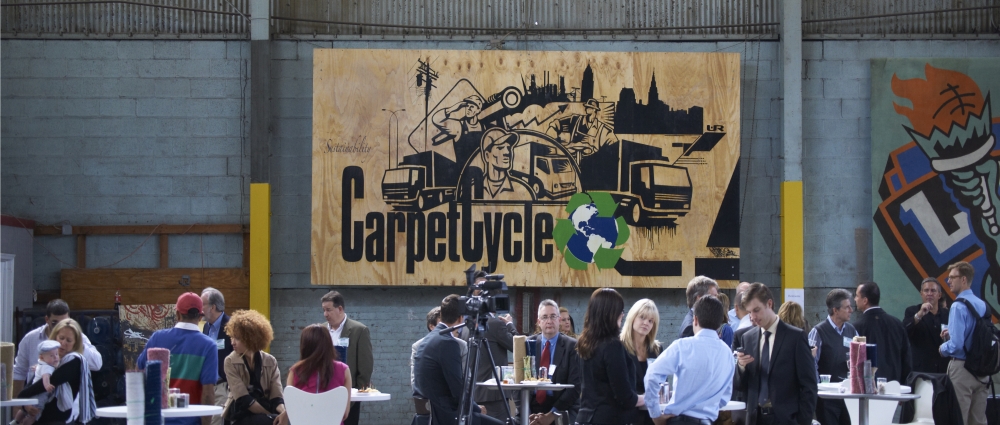News & Stories
Construction Specifier : Circular Economy
Sean Ragiel and Robert Phillips of the CarpetCycle team discuss "The Circular Economy" in this months issue of Construction Specifier Magazine

Presently, natural resources are being extracted at unsustainable rates. The United Nations reports that the extraction of primary materials has more than tripled in the last 40 years. Coupled with a spike in population growth, humankind is burning through resources at an alarming rate.
The circular economy has not been a focal point of architects and designers in the past as factors such as schedule and budget requirements were paramount. Now, with accelerating natural resource depletion, it is becoming increasingly relevant, starting with the specification process. Design professionals' decisions could create a ripple effect toward sustainability throughout the construction industry.
Embracing and correctly implementing a circular economic model - a philosophical change in how one conducts business - can solve current problems with immediate and long-term benefits. Instead of the traditional "take, make and waste" system, the circular economy is a closed-loop regenerative approach of "take, make and reuse." This can help all supply chain entities - from sourcing, manufacturing and operations to end-consumers- become more prosperous.
Diverting waste: Beginning with the end
The first step to changing the economy from linear to circular is reusing or recycling materials. Construction waste is one of the top offenders contributing toward landfill volume. According to the United States Environmental protection Agency (EPA), 484 million tons of construction and demolition debris was generated in the United States in 2014 - more than twice the amount generated by municipal solid waste. A circular economy utilizes closed-loop systems to divert these materials from landfills - recovering or restoring products, components, and materials by reusing, repairing, remanufacturing, or reccling them. When practiced properly, closed-loop recycling can increase the lifespan of a product, which would optimally become infintely regenerative.
Obstacles
Time and care are needed to ensure materials are properly disposed, yet businesses tend to save time utilizing the easiest methods, such as bulk disposal and unrefined delegation to recycling services, to accomplish their goals, which can lead to poor planning for waste diversions. Conventional demolition processes often contribute to contaminated loads of recycling materials. The bulk method calls for all waste to be discarded at the same time. When construction materials are disposed in this manner, they are often contaminated with food and liquid waste, therby ruining the materials' chances of being recycling Specifically, gypsum wallboard (GWB) and ceiling tiles are often crushed during the process, negating the materials' recyclability and contaminating other materials such as carpet.
Bulk disposal also creates additional expenditures for recycling companies, which, in turn, leads to desaturation of local marketing and increased future costs for reclamation.
Additionally, the latest version of LEED and the Manhattan Solid Waste Advisory Board no longer include altrnative daily cover - the practice of using difficult to recycling materials as a top soil like layer for landfills - under waste diversion. This impacts total recycling rates for construction projects and increases the cost of waste diversion.
Solutions
California is aggressively mandating the extended producer responsibility for many consumer products. These EPR programs dictate end-of-life management costs be incorporated into the initial sale of a product. By doing so, California hopes to impart positive change in design and manufacturing practices to reduce waste and build awareness about the circular economy. However, not all states are equally aggressive, and organiazations who initate regenerative practices before govermental mandates will likely have competetive advantages in future costs. Architects and designers who participate in sustainable practices, before required to do so by law, will earn themselves credibility, gain favorable public perception and secure customer loyalty.
When companies have consistent recycling practices, they build stronger relations with recyclers. This helps ensure companies employ proper reclamation practices and negates a recycler's "unknowns", which can dicate higher cost estimations. Stronger relations between business can also result in lower prices. During bidding phases for projects, companies with ongoing relations with recyclers might be able to win bids with an eco-friendly sales pitch.
Lastly, recycling facilities also improve local economies. The EPA
s 2016 Recycling Economic Information report shows the recycling of construction and demolition materials created 230,000 jobs in 2007.
Sourcing: Improving Environment & Communities
In a circular economy. reduction is the fundemental practice when sourcing materials. Materials sourced globally have large impacts on carbon dioxide emissions, and negatively affect the atmosphere. In a 2017 report, the International Council n Clean Transportation (ICCT) found 87 percent of shipping emissions are attributed to international shipping activity, compared to only nine percent resulting from domestic transportation
Obstacles
Recycled material markets are dicated by global market fluctuations, at times creating difficult situations for companies to predict and consistently maintain or gain market shares. Carpet is one industry affected by global material procurement. According to the annual report for Carpet America Recovery Effort, 1.5 billion kg of carpet were discared to landfills in the United States. As carpet mainly comprises petroleum-based materials, oil prices often dicate the market for recycling. As prices drop, the market available for processed recycled carpet materials dissolves.
Solutions
Sourcing with a circular economy model can create immediate cost-savings for shipping and freight. Specifiers should look for locally-sourced products. LEEDv4 credits can be earned for products sourced within 100 miles under the regional priority category. This credit is emphasized by valuing local materials at 200 percent of their base contribution costs. The Living Building Challenge (LBC), an initiative by the International Living Future Insistute, requires 20 percent or more of the construction budget materials to comes from within 310 miles of the project site. Current programs and tracking systems are available for carbon counting anabling design firms to demonstate their environmental responsibility to potential clients. As more products and materials are sourced regionally, it inevitably improves local markets and increases employement. Additionally, LEEDv4 credits are also available through procurement of materials with minimum recycled contents.
Manufacturing: Planning for the Future
The circular economy emphasizes durability, quality and recyclability for sustainable product production. Designing for durability helps ensure an increased life cycle in construction applications. Manufacturing for durability and longevity is the first aspect necessary for properly recycling in a closed-loop or circular economy. Quality products in the circular economy scenario will be durable safe and easily reused or reclaimed at the end of use stage.
The guidelines set by Healthy Building Network for manufacturing safe products is measured by limiting and optimally displacing all potentially hazardous chemicals. This is instrumental in ensuring products have minimal negative healthy effects to end-users, laborers and the environment. High-performance features and non-hazardous components in products are the foundations for applicability to- and the evaluation of- a true circular economy
Check out the full article on: www.constructionspecifier.cm



